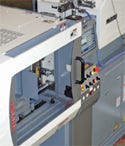Injection overmolding of bondable liquid silicone rubber and two-shot silicone-thermoplastic molding represent recent additions to the U.S. medical molding market.
September 14, 2007
Originally Published MPMN September 2007
PRODUCT UPDATE
Stretching the Possibilities with Silicone Molding Technologies
Injection overmolding of bondable liquid silicone rubber and two-shot silicone-thermoplastic molding represent recent additions to the U.S. medical molding market.
|
The BioSil line of self-bonding silicone formulation is enabled by the supplier’s two-shot silicone-thermoplastic molding capability. |
Design engineers elect to use silicone in a number of medical device applications owing to such inherent properties as biocompatibility, chemical resistance, clarity, resilience, and performance over a wide temperature range. Proven successful in a variety of products, the versatile material is experiencing mounting demand from the medical device market. And as the prevalence of silicone in medical products steadily increases, so does the desire for consolidation of operations and reduction of expenses. Fulfilling this need, two service providers offer exclusive silicone molding capabilities to U.S. medical device manufacturers that eliminate processes, thereby cutting costs.
Injection Overmolding of Bondable LSR
When Tom Balistreri, CEO of Rogan Medical Components (Lake Bluff, IL; www.roganmed.com), saw the bondable liquid silicone rubber (LSR) pioneered by several leading silicone companies, he was awestruck. Promptly pouncing on the potential opportunity presented by the material, Balistreri immediately concentrated his company’s efforts on bringing to fruition the injection overmolding of bondable LSR to plastic substrates.
“I saw this technology and it really opened my eyes to the great advantage that it could provide to design engineers who are designing things like waterproofing seals and gaskets, diaphragms, or valves into their products,” he says. “We decided that we were going to be one of the companies that was going to be involved early in this thing.”
And this decision has given the company a competitive edge. To Balistreri’s knowledge, Rogan is the only company currently offering overmolding of bondable LSR to the medical industry.
The silicone technology has already been put to use in the development of waterproof connectors for wire harnesses used in the automotive industry. But upon witnessing the technology, Balistreri imagined a plethora of possibilities for the material and the associated molding process for medical device applications.
Integrating LSR components into devices has been a hassle for many design engineers, according to Balistreri. Traditionally, these parts are molded separately by silicone liquid injection molders and then brought into the assembly process as added components. They must then be positioned within the application and often require attachment to a mating part. Moreover, the rubbery nature of the material can complicate or prevent proper positioning, which, in turn, can affect functionality and quality of the device.
Overmolding of bondable LSR eliminates much of the added cost and labor associated with silicone components. “By molding this silicone directly on the part, you consolidate components, you eliminate that assembly process, and you eliminate the concern that [incorrect] assembly could create a functional defect,” Balistreri says.
Rogan can overmold the material to a number of plastics, in addition to stainless steel and aluminum. Bondable LSR exhibits good adhesion to such materials as polybutylene terephthalate, polyphthalamide, polycarbonate, polyphenylene oxide, polyamides, acrylonitrile butadiene styrene, and polyetherimide.
Overmolding Eliminates Need for Gaskets
|
Rogan Medical Components claims to be the only company currently offering overmolding of liquid silicone rubber (equipment shown above) to the medical industry. |
This molding capability enables engineers to waterproof housings with complex geometries without the need for a gasket. Incorrect gasket or seal repositioning when servicing a device in the field is no longer a concern either, owing to the overmolded design.
Applications include parts that require waterproofing, such as seals and gaskets, IV and enteral feeding delivery products, and devices with embedded electronics that could be subjected to moisture or bodily fluids. Equipment—especially that used in ambulatory settings—could benefit from overmolded bondable LSR components, as could autoclavable, ergonomic, and soft-touch grips on stainless-steel surgical instruments. Overmolding of the material provides shock and vibration protection and sound dampening as well.
Rogan Medical is not alone in its expanded silicone molding efforts. Taking a cue from its motto, ‘Leading the Way with Innovation,’ Saint-Gobain Performance Plastics (SGPPL; Portage, WI; www.medical.saint-gobain.com) has laid claim to the distinction of being the first U.S. company to offer two-shot silicone-thermoplastic molding to the medical market.
Two-shot silicone-thermoplastic molding was first commercialized in Europe, but until now was unable to penetrate the U.S. medical industry. Despite the success of two- and multishot molding in American manufacturing, limited knowledge of silicone molding among thermoplastic molders has prevented U.S. adoption of two-shot silicone-thermoplastic molding, according to Brad Hanson, medical marketing manager for SGPPL.
“Until this technology was commercialized, designers had to either choose thermoplastic elastomers and sacrifice performance, or assemble silicone parts to mating thermoplastic substrates,” Hanson says.
Manual assembly and the related costs and labor are removed by choosing to two-shot silicone-thermoplastic mold components. In this operation, a silicone and a thermoplastic elastomer component are molded to produce one part.
“We are now able to mold a multimaterial part in one press, under one process,” explains Sarah Gonnering, marketing coordinator for SGPPL. “It allows design engineers much greater design freedom versus other methods. Two-shot molding also provides savings in validation costs and reduction in vendors.” SGPPL enumerates reduction of part cost, flash, runners, and cycle times as additional benefits of the service.
Seals, caps, septums, and soft-touch instruments are among the medical applications suited for this particular molding process. Any silicone and thermoplastic device component that is typically assembled or overmolded, as well as designs that demand complex assembly, is a suitable candidate for two-shot silicone-thermoplastic molding, according to Gonnering.
To complement its molding service, SGPPL has introduced the BioSil SB line of self-bonding silicone formulation, which combines silicone rubber and a range of such substrate materials polycarbonate, PEEK, polyester, polyimide, and phenolic resin. The company’s two-shot molding capability enables the bonding of these materials.
Copyright ©2007 Medical Product Manufacturing News
You May Also Like




